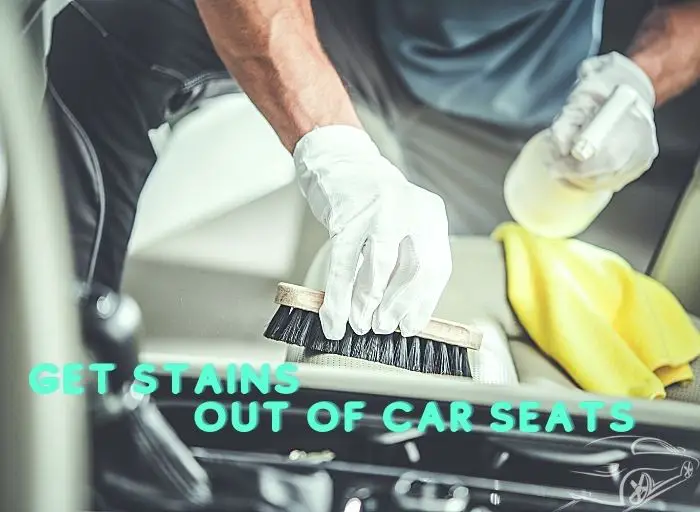
Stains happen.
And when they happen in the car, you can be sure that it will take a lot of scrubbing to remove them.
Welcome to the expert guide on how to get stains out of car seats effectively. With years of experience in car detailing, we’ll share proven techniques to tackle various stains and restore your seats to their pristine condition. Get ready for a spotless ride!
Table of Contents
Factors to Consider When Treating Stains Based on Material
Before jumping into the methods, you should keep in mind some important factors before treating stains on different car seat materials:
- Fabric sensitivity: Assessing how delicate or durable the material is
- Colorfastness: Determining if the material is prone to color bleeding or fading
- Water resistance: Considering if the material repels or absorbs water
- Cleaning instructions: Following any specific cleaning guidelines provided by the manufacturer
- Age and condition: Taking into account the age and condition of the material, as older or worn materials may require more gentle treatment
Also, here are some specific challenges and precautions for each material:
Leather seats: Use leather-specific cleaning products to maintain the material’s natural oils and luster
and you should condition the leather periodically to prevent drying and cracking
Vinyl seats: Use mild cleaners that are suitable for vinyl upholstery and avoid excessive scrubbing or abrasive tools that can scratch or damage the vinyl surface
Cloth seats: Use fabric-specific cleaners that are safe for the particular type of cloth and blot stains gently to avoid spreading or pushing the stain deeper into the fabric
Suede or microfiber seats: Avoid excessive moisture, as suede and microfiber can be sensitive to water
Nylon seats: Be cautious with heat or high-temperature cleaning methods, as nylon can be sensitive to heat
Combination materials: Identify the primary material, follow the cleaning guidelines for that specific material, and be mindful of any secondary materials or trimmings with different cleaning requirements.
How to Get Stains Out of Car Seats

To get the job done right, you need two things: the right products and techniques.
What products can I use to get stains out of my car seats
You can use several products to effectively remove stains from car seats. Here are a few options:
Upholstery cleaner
Look for a specifically formulated upholstery cleaner that is safe for use on car seats. These cleaners are designed to lift and remove stains without causing damage to the seat material.
Some examples are:
- Meguiar’s Carpet & Upholstery Cleaner: This upholstery cleaner is known for its effective stain removal capabilities and is suitable for use on various fabrics, including car seats.
- Chemical Guys Fabric Clean Carpet and Upholstery Shampoo: This cleaner is specifically formulated to remove tough stains from fabric surfaces, making it a popular choice for car seat cleaning.
- Turtle Wax Power Out! Upholstery Cleaner: Designed to tackle stubborn stains, this upholstery cleaner can help lift and remove deep-seated stains from car seats.
Stain remover
You can find various stain remover products on the market that are specifically designed to target different types of stains, such as food, beverages, grease, ink, and more. Make sure to choose a stain remover suitable for the type of stain you are dealing with.
Here are two examples:
- Resolve Multi-Fabric Stain Remover: This stain remover is designed for use on different fabric surfaces, making it suitable for car seats. It is known for targeting and eliminating various stains, including those caused by food and drinks.
- Mothers Carpet & Upholstery Stain Remover: Mothers offers a stain remover specifically formulated for car interiors. It can effectively tackle stains on car seats, carpets, and upholstery, leaving them clean and fresh.
Enzyme-based cleaner
Enzyme-based cleaners are effective for removing organic stains, such as those caused by pet accidents, urine, vomit, or food spills. These cleaners break down the organic matter, eliminating the stain and odor.
Baking Soda

Baking soda is a versatile and affordable household product that can absorb odors and help lift certain types of stains. Sprinkle baking soda over the stained area, let it sit for a while, and then vacuum or brush it off.
White vinegar
Vinegar is a natural cleaning agent that can tackle some stains and odors. Dilute white vinegar with water and apply it to the stain, then gently blot or scrub the area. Remember to rinse the seat thoroughly afterward.
Warm water and mild detergent
A mixture of warm water and mild detergent can be effective for general cleaning and mild stains. Dampen a clean cloth or sponge with the solution and gently blot the stain.
General Stain Removal Techniques Applicable to Most Stains
When it comes to removing stains from car seats, several general techniques can be applied to most types of stains. These techniques effectively tackle common stains and can be used as a first step in stain-removal.
- Act quickly: It’s important to address the stain as soon as possible to prevent it from setting into the fabric. The longer a stain sits, the harder it becomes to remove.
- Blot, don’t rub: Use a clean, absorbent cloth or paper towel to blot the stain gently. Avoid rubbing the stain, as this can spread it further and damage the fabric.
- Remove excess residue: If any solid or semi-solid residue is on the seat, carefully scrape it off using a plastic utensil or the edge of a credit card. Be cautious not to damage the seat material.
- Test cleaning solutions: Before applying any cleaning solution to the entire stain, test it on a small, inconspicuous area of the seat to ensure it doesn’t cause any discoloration or damage. Wait for a few minutes and check for any adverse reactions.
- Use mild detergent or upholstery cleaner: Prepare a solution of warm water and a mild detergent or upholstery cleaner. Follow the manufacturer’s instructions for the appropriate dilution ratio. Dip a clean cloth or sponge into the solution and gently dab it onto the stain.
- Blot and repeat: Blot the stain with the cleaning solution, working from the outer edges towards the center. Avoid scrubbing vigorously, as this can damage the fabric. Repeat the process until the stain starts to lift or fade.
- Rinse with clean water: After removing the stain, dampen a clean cloth or sponge and blot the area to remove any soapy residue. This helps prevent any sticky or soapy residue from attracting dirt and causing the stain to reappear.
- Allow to dry: After cleaning, let the seat air dry completely. Avoid using excessive heat, as it can cause certain materials to shrink or become distorted.
- Vacuum or brush: Once the seat is dry, gently vacuum the surface or use a soft-bristle brush to restore the fabric’s texture and remove any remaining particles.
How To Get Water Stains Out Of Car Seats
Step 1. Clean the cloth car seat first with warm water to remove any loose dirt and grime.
Step 2. Add a tablespoon of mild dishwashing detergent into the water; wet the area with clean water.
Step 3. Scrub the area under running water with an old toothbrush while applying light to medium pressure on the stained areas depending on the severity of the stain. Continue scrubbing until all stains are removed or until you can no longer see any more stains.
How To Get Water Stains Out Of Leather Car Seats
Method 1: Using lye
Step 1: Clean the leather car seat with warm water and mild soap.
Step 2: Once you have washed the leather car seat, dry it by sprinkling more clean water over it to ensure all water is gone.
Step 3: Add a teaspoon of pure lye into the mixture of warm water and dishwashing liquid from Step 1; stir well to mix in with all other ingredients so that no part of the mixture will be left out.
Find out: Ways to deep clean your car’s carpet without an extractor!
Step 4: Spray the mixture onto the stain and scrub it using a soft-bristle brush. Apply very light pressure, especially when rubbing on new leather car seats, because the leather will be new and tend to scratch easily.
Step 5: Continue this process until you can no longer see stains.
Method 2: Using baby shampoo
Step 1: Clean the leather car seat with cold water and apply a very mild baby shampoo. Rinse it out with hot water and dry it off with a towel.
Step 2: Place a towel saturated with cold water on the leather car seat to absorb excess moisture. Keep doing this until the towel remains dry.
Step 3: Use a clean piece of cloth to wipe off any remaining moisture.
Step 4: After you have waited for five minutes, wipe off the leather with a clean microfiber cloth and let it dry for about ten minutes. Ensure you can see it is completely dry before using it again.
Find out: How to seal your car’s leather seats!?
How to Get Food and Beverage Stains Out Of Car Seats
For detailed instructions to remove food and drink-related stains, you can follow this guide:
Step 1: Prepare a cleaning solution
Depending on the type of stain and the material of the car seat, you can use different cleaning solutions
- General solution: Mix warm water with a mild detergent or upholstery cleaner.
- For coffee or tea stains: Try a mixture of warm water and mild detergent.
- For soda or juice stains: Use a mixture of warm water and a small amount of white vinegar.
- For grease or oil stains: Apply a small amount of dishwashing liquid to warm water.
Step 2: Apply the cleaning solution
Dampen a clean cloth or sponge with the cleaning solution and gently blot the stain. Work from the outer edges toward the center of the stain. Avoid excessive scrubbing, as it may damage the fabric.
Step 3: Rinse and blot
After applying the cleaning solution, rinse the area with clean water to remove any soapy residue. Blot the seat with a clean cloth or sponge to absorb the excess moisture.
Step 4: Repeat if necessary
If the stain persists, repeat the cleaning process or try a specialized upholstery cleaner designed for food and beverage stains. Follow the product instructions carefully.
Step 5: Air dry
Allow the seat to air dry completely before using it. Avoid using excessive heat, as it can cause certain materials to shrink or become distorted.
Check out this video on how to remove coffee stains from car seats!
How To Get Blood Stains Out Of Car Seats
Step 1. Clean the cloth car seat first with warm water to remove any loose dirt and grime.
Step 2. Take a clean towel already soaked in cold water and place it on top of the stain for a couple of minutes.
Step 3. Once you have waited a couple of minutes, take another clean towel and soak it in warm water; wring out excess water so that it is not too wet but not too dry.
Step 4. Place this warm towel on top of the stain for a couple of minutes before taking another warm towel and repeat the process.
Step 5. After doing this three times, apply all over shampoo to remove all of the stains in one go. Let it sit for ten seconds before scrubbing it with a scrub brush using a gentle circular motion.
How to Get Vomit and Urine Stains Out Of Car Seats
To effectively remove vomit and urine stains from a car seat, follow these steps:
Step 1: Wear gloves and remove any solid or semi-solid matter from the seat using a plastic bag or paper towel.
Step 2: Blot the stained area gently with a clean cloth or paper towel to remove excess liquid. Avoid rubbing the stain, as it can spread and push it deeper into the fabric.
Step 3: Mix a solution of warm water and mild detergent. Alternatively, you can use an enzymatic cleaner designed specifically for pet stains, which can be effective in neutralizing odors.
Step 4: Dampen a clean cloth or sponge with the solution and blot the stain. Start from the outer edges and work your way toward the center. Continue blotting until the stain begins to lift.
Step 5: Rinse the area with clean water to remove any soapy residue. Blot with a clean cloth or sponge to dry the seat.
You may need a specialized upholstery or enzyme-based cleaner for stubborn stains or lingering odors. Follow the product instructions carefully, and test it on a small, inconspicuous seat area first to ensure it doesn’t cause discoloration or damage.
After removing the stain and odor, allow the seat to air dry completely. Avoid using excessive heat or direct sunlight, as it can cause certain materials to shrink or become distorted.
Specialized Techniques for Removing Lipstick, Makeup, and Nail Polish Stains

These stains are a bit special as we need to use the right chemical to remove them completely. Here is how:
Step 1: Scrape off any excess lipstick, makeup, or nail polish using a plastic utensil or the edge of a credit card.
Step 2: Apply a small amount of non-acetone nail polish remover or rubbing alcohol to a clean cloth or cotton ball.
Gently dab the stain, starting from the outer edges and moving inward.
Step 3: Blot the area with a clean cloth or paper towel to absorb the stain and cleaning solution.
Step 4: Rinse the area with clean water and blot dry. Repeat if necessary.
Note: Test the nail polish remover or rubbing alcohol on a hidden seat area first to ensure it doesn’t cause discoloration or damage.
How to Prevent Future Stains on Car Seats
If you have to clean car seats regularly, it’s very tiresome. So, here are some tips to prevent future stains appearing on your car seats.
Establish and enforce rules
Set clear guidelines for passengers, especially children, regarding food and drink consumption in the car. Encourage them to consume snacks and beverages in designated areas away from the car seats.
Use seat covers
Consider using removable seat covers or protectors specifically designed for car seats. These covers act as a barrier between spills and the actual seat fabric, making cleaning and protecting the seats from stains easier.
Avoid eating while driving
Discourage eating while driving to minimize the risk of food spills and stains. Instead, encourage passengers to enjoy their meals at designated rest areas or when the vehicle is parked.
Properly seal containers
When carrying drinks or food items in the car, ensure that containers are securely sealed to prevent accidental spills. Use spill-proof travel mugs or containers with tight-fitting lids to reduce the likelihood of liquids leaking onto the seats.
Regularly vacuum and clean
Implement a routine cleaning schedule for your car seats. Vacuum them regularly to remove dirt, debris, and crumbs that can lead to stains. Additionally, periodically clean the seats using appropriate cleaning methods to maintain their appearance and prevent the buildup of stains over time.
How To Prevent Water Stains On Car Seats
- Make sure you keep the car seats clean by vacuuming them every week. Whenever water, mud or mud, etc. has stuck to the car seat, use a towel to wipe it off immediately to prevent the material from absorbing too much of whatever is stuck onto it, which can lead to stains and dirt buildup over time.
- Speaking of dirt, ensure you always wipe off any dirt or spills right away so they don’t cause stains on the cloth and leather car seats.
- If there happens to be a spill on the car seat, use a damp paper towel to wipe it up immediately and avoid letting it sit in the wet area because it will get wet, and you will have to clean it again.
- Remember never to leave trash inside the car while running, as this can be a potential fire hazard.
Read more: How to clean between your car seats?!
7 Tips for Getting Stubborn Stains Out of Seat
- Before starting any work on the seats, be sure to cover the upholstery with a towel or plastic bag to prevent further staining!
- Use a mild cleaning solution and a pumice stone to remove those stains.
- Try rubbing the area gently with a pumice stone and soap flakes for set-in stains. It may take a few minutes, but the results are well worth it!
- To remove those tough stains from the seats, try soaking the area for twenty minutes in warm water with some laundry detergent.
- Remove the stain with dishwashing liquid or bar soap, then rinse the area thoroughly.
- For lighter stains, use a wet wipe and clean gently.
- For stubborn stains, you can mix together one tablespoon of white vinegar with a cup of hot water, then add a squirt of dishwashing liquid or laundry detergent to the solution and soak for an hour. Rinse well when done.
While these tips should be enough to get most stains out of your car seats, if you ever doubt a stain, take the seat out and examine it under a light. If you can scrape some information from the stain that will help you figure out how to remove it, do so! And then make sure the area is completely dry before putting the seat back in!
Check out: How often you can polish your car for a better look?
Check out this video also for how to clean cloth car seats!
Frequently Asked Questions
How do I remove an old and stubborn stain?
You can try using a specialized stain remover or upholstery cleaner specifically designed for the type of stain and seat material. If the stain persists, seeking professional assistance or considering reupholstering the seat may be necessary.
Can I use bleach or harsh chemicals on car seats?
Using bleach or harsh chemicals on car seats is generally not recommended, as they can cause discoloration, damage the seat material, and pose health risks. Instead, opt for mild and gentle cleaning solutions specifically formulated for upholstery and follow the manufacturer’s guidelines for cleaning and maintenance.
What if the stain reappears after cleaning?
If the stain reappears after cleaning, it could indicate that the stain has penetrated deeper into the seat material or that the cleaning process was not thorough enough. In such cases, it may be necessary to repeat the cleaning process using more intensive methods or consult a professional cleaner for assistance.
How often should I clean my car seats?
The frequency of cleaning car seats depends on several factors, such as the level of usage, the likelihood of spills or stains, and personal preference. As a general guideline, aim to clean your car seats at least every few months or more frequently if they are subject to heavy use or if spills and stains occur frequently.
Can I machine wash car seat covers?
Whether car seat covers are machine washable or not depends on the specific material and manufacturer’s instructions. Some seat covers can be safely machine-washed on a gentle cycle, while others may require hand washing or professional cleaning. Always refer to the care instructions provided by the manufacturer to ensure proper cleaning and maintenance of your car seat covers.
Are there any natural or eco-friendly stain removal options?
Yes, natural and eco-friendly stain removal options can be effective in treating certain types of stains. For example, a mixture of baking soda and water can be used to absorb odors and gently lift stains. Additionally, vinegar diluted with water can help neutralize odors and tackle some types of stains.
However, it’s important to note that natural remedies may not be as effective for all types of stains.
Conclusion
Just like you must clean your home and car regularly, you must also clean the car seats. The longer you leave it, the harder it will be for you to remove dirt and grime buildup. Make sure that you clean the car seat frequently, depending on how often they are used, by running a vacuum cleaner over them to quickly wipe off any leftovers.
Further Reading:
Hi everyone, My name is Ollie Barker.
As a seasoned auto expert I have 25 years of experience working in repair and detailing shops. I love to share my tips & tricks to all car lovers, so that’s why I’m here at Automotive Gearz publishing my content, sharing my passion. Also, I’ve been giving my recommendations on which products are the best to have on the market. I always thought it was hard to pick the right part, so hopefully I can make that a bit easier for you.
Hope you enjoy your time on my little blog!







